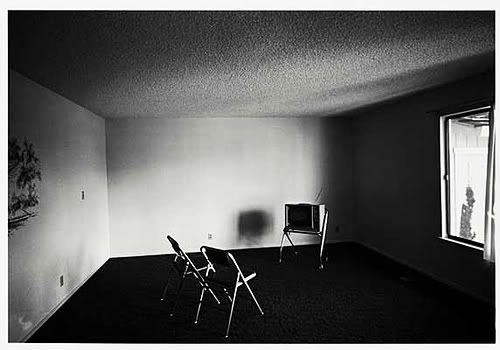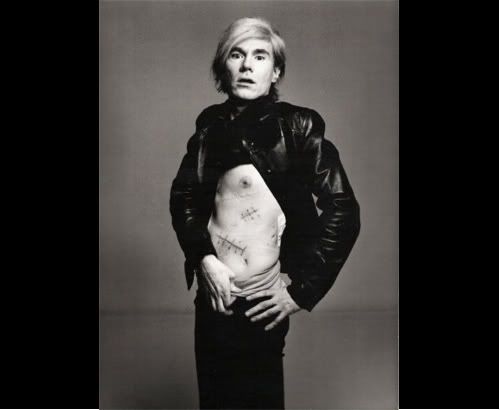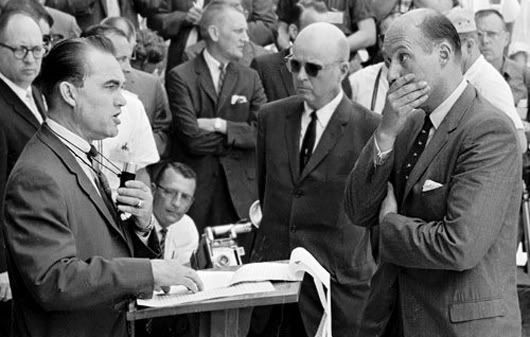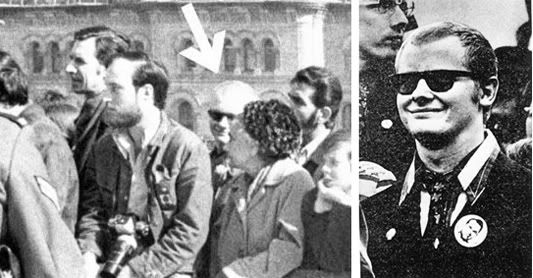
"Sirhan Sirhan shot Robert F. Kennedy. And Ethel M. Kennedy shot Judith Birnbaum. And Judith Birnbaum shot Elizabeth Bochnak. And Elizabeth Bochnak shot Andrew Witwer. And Andrew Witwer shot John Burlingham. And John Burlingham shot Edward R. Darlington. And Edward R. Darlington shot Valerie Gerry. And Valerie Gerry shot Olga Giddy. And Olga Giddy shot..."
- J.G. Ballard, “The Generations of America"
"The Andy Warhol prophecy of 15 minutes of fame for any and everyone blew up on our doorstep."
- Lance Loud
Altamont, post-Tet Vietnam, the Manson trail, Attica, skyjackings on an almost daily basis, economic decline. What the hell happened? It wasn't supposed to be like this, living in America in the late twentieth century. The economic affluency and social certainty of the post-War boom, the ascendant "American Way of Life" of a decade prior had pointed to another horizon, to an entirely different future. The outlook of that era couldn't have been more optimistic, more assured.
The artist of that earlier, not-too-distant past had been Andy Warhol. Everyone knows the artist's Greatest Hits -- the parades of soup cans, Brillo boxes, gunslinging Elvises, etcetera. All the flat, emblematic, serialized signifiers and mass-produced objects of a new, modern consumerist society blankly mirrored back to itself. But behind all the sharp and glimmering surfaces of those objects lay a shadow; that shadow being death -- death imported into the fabric of modern life in new and improved ways. There was the enshrinement of the suicided sex symbol, then the first lady in numbed and unimaginable shock on a certain fateful day in Dallas. Death, death and still more death. State-mandated death by electric chair, and self-actualized death from leaping off of a skyscraper. Death in car crashes, in plane crashes, and lurking in tainted tins of tuna fish.
Perhaps one can invoke only so much death and morbidity before fate itself reciprocates by finding a place for you in its Rolodex. For Warhol, death would arrive one June afternoon in 1968 in the form of three slugs from a .32 calibre pistol, the pistol wielded by disgruntled and deranged ex-associate Valerie Solanas. Briefly and officially declared dead by doctors after the shooting, Warhol managed to survive the attack.

Andy's chest.
In his 1975 autobiography, Warhol would write, "In the '60s everybody got interested in everybody. In the '70s everybody started dropping everybody. The '60s were clutter. The '70s are very empty." In the end, he was most likely talking about himself. After the shooting, Warhol began living a more guarded and less accessible existence. Some would argue that the latter part of the statement very much sums up the artists's career during the 1970s. No more art with a grim or ironically critical subtext. The 'seventies for Warhol were the decade in which making art meant making money, and the artist found that he could do this by simply resting on his laurels, settling into a formulaic signature style, and cranking out portraits of celebrities, socialites, and wealthy collectors.1 He'd also spend the decade toadying to glamorous and powerful patrons (among whom could be counted Empress Farah Dibah Pahlavi and her husband, the Shah of Iran), and hanging out with the likes of Bianca Jagger and Liza Minnelli at Max's KC or Studio 54. And then there was launch of his own show-biz/society magazine Interview, a publication devoted to aimless chit-chat with people who were famous, or angling to become famous.
One good way to become famous in America during the 1970s was to shoot somebody who was famous. Preferably an elected official. You didn't need a political motive. The target didn't have to be someone who was especially beloved by the public. You didn't even need to be a decent enough marksman to properly finish them off. None of that mattered, because it still made for good theater. Ask Arthur H. Bremer. A socially maladjusted and marginally employable young man hailing from Milwaukee, Bremer originally set out to shoot president Richard Nixon (who was running for re-election in 1972), but wound up shooting would-be Democratic contender George Wallace, instead.
Wallace, for those who need a reminder, was the two-term governor of the state of Alabama. In the prior decade, he’d attained notoriety for having opportunistically opposed desegregation. He'd physically blocked enrollment of black students at the University of Alabama in 1963, and had defiantly proclaimed, "Segregation now, segregation tomorrow, segregation forever." In 1972, he was making his third bid for the presidency, this time running on the Democratic ticket. Regarded as the "Spoiler from the South" by the press, Wallace had proven a formidable contender. He was, by one journalist's description, "a Southern populist of the meanest streak," and in 1972 he posed a considerable threat to both the Democratic ticket and to president Richard Nixon. On the campaign trail, he stumped on a staunch law-and-order plank, and vociferously decried the increased liberalism, civil disorder, and "moral decay" of the 1960s. All of which met with a warm welcome with Nixon’s "silent majority."

Wallace, squaring off with the feds at the University of Alabama in 1963
Wallace's run for the White House was, of course, troubling for some Americans. Even though by 1972 he'd denounced his prior pro-segregationist platform, Wallace proved that he wasn't above exploiting the racial tensions surrounding the federally-mandated school busing program for his own political gain. His campaign speeches were the epitome of unbridled demagoguery -- podium-thumping screeds of anti-federal rhetoric aimed at the intrusive, do-gooder meddling of the "briefcase totting," "pointy-headed bureaucrats in Washington," interlaced with mockery of a diffuse and unnamed elite of "hypocrites" and "intellectual snobs" who reputedly shaped the nation’s social and economic policies.
To the alarm of many in the press and public at large, Wallace’s message found a broad and receptive audience, particularly among disenfranchised or alienated blue-collar and middle-class voters. On the campaign trail he met with enthusiastic and overflowing crowds when he appeared at rallies in Wisconsin and Michigan. Covering the Democratic primaries for Rolling Stone magazine, journalist Hunter S. Thompson declared, "George Wallace is one of the worst charlatans in politics," further observing: "But there is no denying his talent for converting frustration into energy. ...The frustration was there, and it was easy enough to convert it -- but what then?" The danger, Thompson recognized, was that Wallace was ultimately "stirring up more anger than he knew how to channel." 2
Not that any of that mattered to Artie Bremer, he was just looking to make a name for himself. He'd first set out with Richard Nixon in mind as his target. For weeks he shadowed Nixon's campaign stops, chronicling his journeys in a diary as he went. Hapless and unfocused in his stalking, there was one aspect of his task that he was deeply attentive to -- his appearance. Bremer wanted to make sure he did the job in style. He didn't want to be taken for some disheveled loser or -- even worse -- some sort of hippie. He put a great deal of thought and effort into his wardrobe and his grooming in order to meet each opportunity to shoot the president looking like a normal, clean-shaven, patriotic citizen.

Bremer, photographed by security at a pair of rallies in the late spring of 1972
At one point, spying Nixon’s car outside the American embassy in Ottawa, Bremer realized that he had been caught by surprise and wasn't properly dressed for the occasion. He dashed back to his hotel room to change and smart himself up, returning to the embassy to find that Nixon had already departed. Furious with himself, he wrote in his diary:
“I wanted to shock the shit out of the [Secret Service] men with my calmness. .... All these things seemed important to me, were important to me, in my room. I will give very little if ANY thought to these things on my future attempts. After all does the world remember if Sirhan’s tie was on straight?”
Yet, attending a Nixon rally a day later, he witnessed the same Secret Service personnel targeting rank-and-file protesters, and noted incredulously, "WOW! If I killed him while wearing a sweatty tee-shirt, some of the fun & Glamore would defionently be worn off [sic x 4]."
But eventually Bremer did draw the attention of Nixon's security detail, which prompted him to quickly change plans. After briefly considering Democratic frontrunner George McGovern, he instead set his sights on Wallace. In his diary, Bremer bemoaned the diminished media coverage his lower-profile target would attract, yet that didn’t dissuade him from contemplating what sort of clever one-liner he'd deliver before pulling the trigger.3 Within a week of trailing Wallace, he shouldered through the crowd in a shopping center parking lot in suburban Laurel, Maryland, approaching the candidate as he shook hands with supporters after a campaign speech. At close range, he emptied his revolver, shooting Wallace four times and critically injuring three bystanders.

In much the same way that acts of terrorism are efforts to intervene in the machinations of history or global politics by way of the "communicability of images" that surround such events, so too can an attempted assassination -- no matter how botched or incoherently motivated -- be regarded as an effort to disrupt the hierarchy of society’s symbolic order. If political assassinations in the U.S. of the 1960s were unanimously spoken of in terms of martyrdom and "national tragedy," then in the decade that followed they often took on an element of absurdity. Perhaps it comes down to the power of contemporary cultural myths, and the deflation of same that transpired in the 1970s. One such myth being that in a supposedly classless society any citizen could "grow up and become President." If anything, the 1960s and 1970s provided frequent reminders that, instead, it was much easier to be the person who grew up to take a shot at the President.
As with Warhol, George Wallace survived the shooting; although the attack would derail his bid for the presidency and leave him a paraplegic for the remainder of his life. Arthur Bremer would receive his desired 15 minutes of fame, which ended up translating into a 65-year prison term. Upon sentencing, Bremer reportedly told the court, "Looking back on my life I would have liked it if society had protected me from myself."
Shortly thereafter, somewhere on the West Coast, aspiring screenwriter Paul Schrader wasn’t doing so well. Estranged from his wife and living out of his car, Schrader found himself contemplating the emotional effects of loneliness on the male psyche. He had also been reading Bremer's newly published diaries, and from there he got it in mind to write a script about an existentially adrift NYC cab driver. The resulting film, as we all know, would become a huge and controversial success a few years later -- controversial due to its brutally violent content as its use of a former Disney child actress playing the role of a twelve-year-old hooker. The actress was Jodie Foster, who would inspire an amorous fan from Colorado by the name of John Hinckley to begin plotting ways of gaining her attention.
"And Olga Giddy shot Rita Goldstein. And Rita Goldstein shot Bob Monterola. And Bob Monterola shot Barbara H. Nicolosi. And..."

- - - - - - - - - - - - - - - - - - - - - - - - - - - - - - - - -
NOTES:
1. This was, as art critic Matthew Collings has called it, Warhol's "doing uncritical portraits of anyone who could pay period."
2. It's been argued that Wallace was an early pioneer of the contemporary "politics of rage" -- the backlash rhetoric that has been the primary parlance of the culture war waged by American conservative movement over the past 3 decades. It was for this reason that historian Dan T. Carter declared Wallace "the most influential loser in twentieth-century American politics."
3. In keeping with the culture of paranoia at the time, it bears pointing out that this account (diary excerpts in particular) has been contested. There were at the time a number of conspiracy theories surrounding the attempt of Wallace’s life -- theories hailing from both the Left and the Right ends of the political spectrum. Records show that in the hours following the shooting, Nixon and his aides were scrambling to find a way to plant evidence that would tie Bremer to the campaign of Nixon's leading Democratic opponent, Senator George McGovern. For this reason, the American author Gore Vidal would soon assert in the pages of the New York Review of Books that Bremer’s diaries were a fraud, alleging that that had been authored by one of Nixon's henchmen and planted among Bremer's belongings by the C.I.A.
3 comments:
Excellent stuff. The recent Arizona shootings also brought Larry Flynt to mind. Another influential character embodying the 'American dream' to the discomfort of many. Have you read 'The Dream Life' by J. Hoberman? Highly recommended if you haven't.
There was also the (appositely klutzy) assassination attempt on Gerald Ford:
http://andwhatwillbeleftofthem.blogspot.com/2010/10/charlie-dont-surf.html
Hey, thanks Wayne.
Actually, there were two attempts on Ford. One by former Manson Family member 'Squeaky' Fromme, and then one by another woman (who was associated with the SLA) just a couple of weeks after Fromme's. I had wanted to reference that in the piece, but couldn't figure out a way to do it w/o it seeming excessive.
Yeah, I've been wanting to read the Hoberman book lately, but it appears some grad student has it on extended check-out from the university library.
And the timeliness of the post (re: Arizona) is purely coincidental. I guess some things are "distinctly American."
Well, in the UK we're more used to bombing than assassination. More anonymous, less 'celebrity' orientated - and of course because guns are much harder to purchase (although we still get our share of crazies going 'postal').
I didn't know about the second Ford attempt. For such a non-entity, Ford certainly had a role in a lot of volatile events - wasn't he a big kahuna in the Warren commision too?.
I forgot to include SLA's Donald Defreeze as a forerunner of rap (with his rather lyrical threats).
Post a Comment